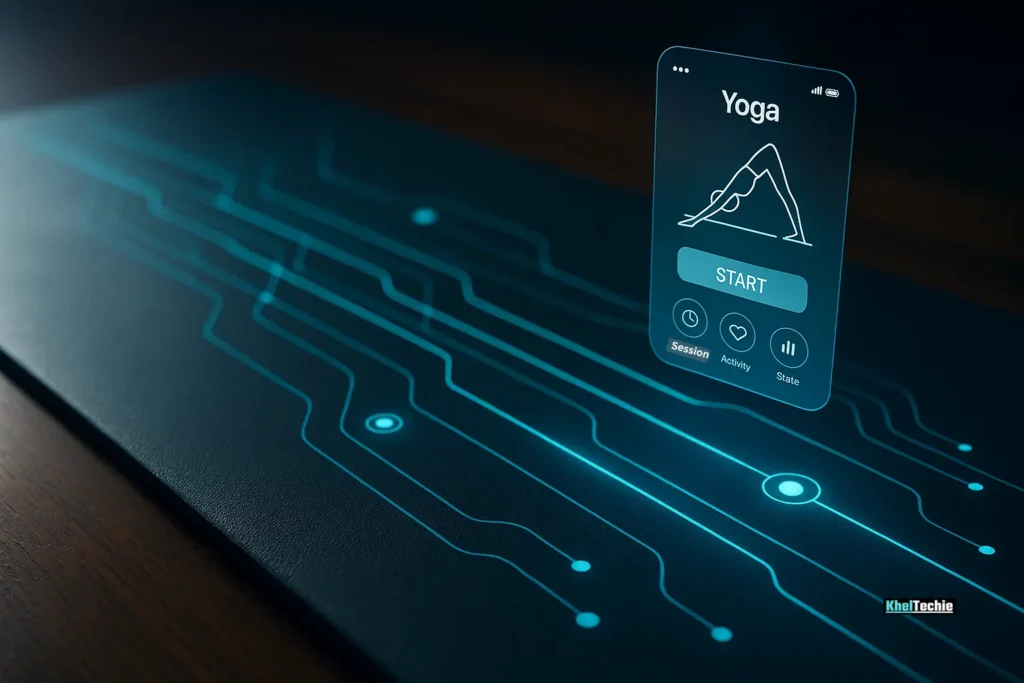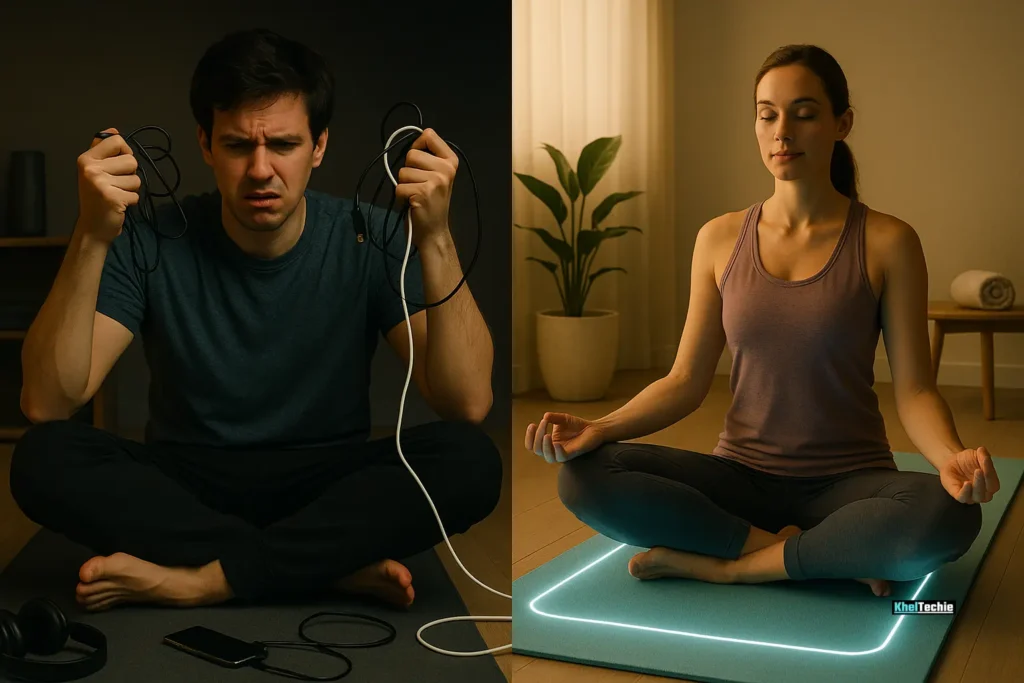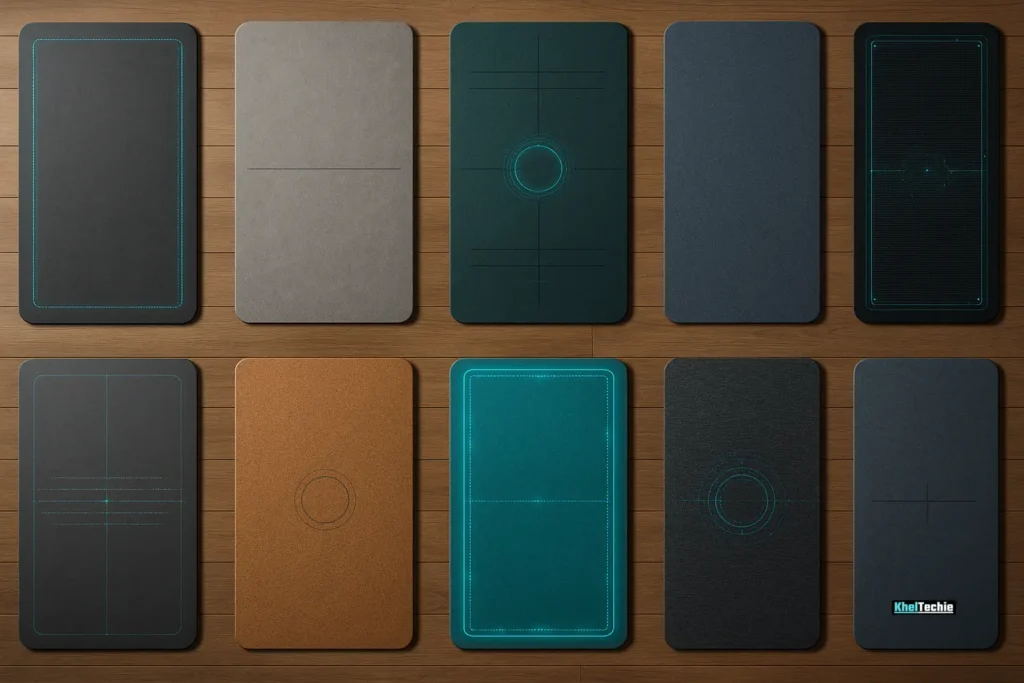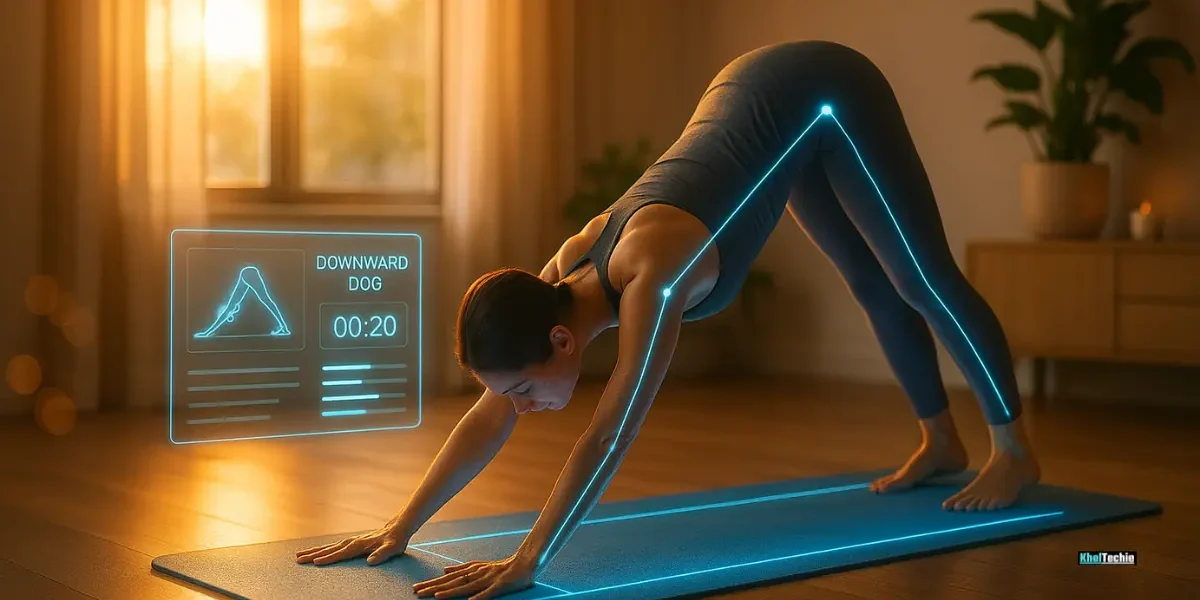Smart Yoga Mats: Are They Worth It? Your Ultimate 2025 Guide
The Solo Yogi’s Dilemma!
Ever found yourself mid-Downward Dog, wondering, “Am I aligned right?” If so, you’re not alone. Many people who practice yoga at home often feel uncertain about their posture, balance or whether they’re doing a pose correctly. This is where the buzz around smart yoga mats begins to make sense. With embedded sensors, real-time feedback and app integration, these mats promise to bridge the gap between solo practice and guided instruction.
But here’s the question: Are smart yoga mats worth it?
In this article, we’ll walk through everything you need to know from how they work, what features matter and whether the price tag justifies the benefits. Whether you’re a beginner or a seasoned yogi, by the end of this guide, you’ll have all the tools to decide if a smart yoga mat belongs in your wellness routine.
Also read – Beginner’s Guide to Yoga for Flexibility

What Exactly Is a Smart Yoga Mat?
A smart yoga mat is more than just a cushioned surface for downward dogs and sun salutations. These high-tech mats are embedded with sensors, pressure points and Bluetooth connectivity that sync with companion apps to offer:
- Real-time posture feedback
- Movement tracking
- Personalized alignment suggestions
- Breathing guides
- Session analytics
Think of them as your personal yoga coach, minus the hourly rate.
Some even connect with popular fitness platforms like Apple Health, Fitbit or Peloton, allowing you to track your practice alongside other wellness metrics.
Types of Smart Yoga Mats:
- Basic Smart Mats: Pressure sensing and app-based feedback only.
- Advanced Smart Mats: Include posture tracking using computer vision or AI, integration with wearables.

Why Smart Yoga Mats Matter in 2025?
Smart yoga mats are making waves in 2025 and not just as trendy gadgets. According to Grand View Research, the smart yoga mat market reached $204.6 million in 2024 and is expected to grow at a 7.1% rate per year through 2030. That’s almost double the speed of regular yoga gear, showing people are really starting to trust and invest in smarter ways to practice at home.
Even better, this isn’t buzz. A May 2025 peer-reviewed study published in IJRASET, smart yoga mats, when combined with camera feedback, were able to recognize poses with up to 97% accuracy. That’s a big deal because it means these mats can help correct your posture in real-time, just like a real yoga teacher would.
So next time you’re unrolling your mat, know this tech is no gimmick. It’s backed by serious growth and hard science. In short, Smart yoga mats now offer proven, real-world benefits and not just for yogis chasing trends. They’re shaping up to be a valuable tool for anyone wanting real-time feedback, better form and safer alignment with no studio required.

Step-by-Step: How Smart Mats Actually Work
Let’s break it down into bite-sized pieces so you understand exactly what you’re paying for.
1. Choose Your Mat
There are several brands on the market, each with different features. Popular ones include:
- YogiFi Smart Yoga Mat
- Manduka PRO Yoga Mat
- Gaiam Connected Mat
- Liforme Yoga Mat
Each offers unique selling points like sensor density, app integrations and compatibility with voice assistants. Read customer reviews and check return policies before buying.
2. Set Up Your Space
Place your smart yoga mat in a quiet area with enough space to move freely. Most mats require charging via USB and pairing with an app via Bluetooth.
3. Download the App & Pair
Once connected, open the app (usually iOS/Android compatible) and follow the setup wizard. Some apps may ask for your height, weight, and flexibility level to personalize your experience.
4. Start a Session
Most apps offer guided flows, pose libraries and breathing exercises. As you move through poses, the sensors in the mat detect your body’s position and pressure distribution.
Use headphones for audio cues and privacy.
5. Get Feedback in Real Time
During your session, the app will alert you if your alignment is off, like leaning too far forward in plank or lifting your hips too high in downward dog.
Some apps even use AI to suggest modifications based on your movement patterns.
6. Review Your Progress
After your session, review your performance. Metrics might include:
- Pose accuracy (%)
- Balance score
- Pressure distribution heatmaps
- Duration per pose
This data helps you track improvement over time and identify areas needing attention.

Pros & Cons of Smart Yoga Mats
| ✅ Advantages | ⚠️ Drawbacks |
|---|---|
| Real-time pose feedback | High cost ($149–$349) |
| Encourages consistency | Requires battery charging |
| Ideal for beginners & solo users | Learning curve for setup |
| Posture analytics & injury prevention | May not replace instructor fully |
| Gamified experience | Privacy/data storage concerns |

Common Mistakes to Avoid When Buying a Smart Yoga Mat
Even experienced buyers can fall into traps when shopping for smart yoga mats. Here are some common mistakes and how to avoid them.
| Mistake | Why It Matters | How to Fix It |
|---|---|---|
| Ignoring sensor quality | Poor sensors = inaccurate feedback | Check specs: look for 100+ pressure sensors |
| Not reading return policies | Returns are often complicated | Buy from retailers with 30+ day returns |
| Skipping app reviews | The app is key to usability | Check app store ratings and user feedback |
| Assuming all mats are waterproof | Many aren’t sweat-proof | Look for water-resistant materials |
| Overlooking battery life | Some mats die mid-session | Choose mats with 6+ hours of use |
I once bought a budget smart mat only to find the app crashed constantly. Save yourself the headache, stick with trusted brands.

Smart Yoga Mat Comparison: Top 10 Picks for 2025
| Mat Name | Sensors | App Features | Battery | *Price (in USD) | Best For |
|---|---|---|---|---|---|
| YogiFi Gen 3 | High-precision grid | AI feedback, real-time tracking | ~8 hrs | $199 | Home practice, real-time coaching |
| Liforme Live | Alignment + sensors | Live feedback, guided flows | ~10 hrs | $400+ | Eco-conscious yogis, superior grip |
| SmartMat Orca | Pressure + alignment grid | Heatmaps, pose correction, multi-user support | ~9 hrs | $329 | Visual learners, families, tech fans |
| Generic Bluetooth | Basic sensors | Pose count, workout logging | 5–8 hrs | $150–$250 | Budget users, light tracking |
| YogiFi Gen 2 | Multi-zone pressure | Real-time posture correction | 7–8 hrs | $189 | Beginners, compact needs |
| Welltory Yoga AI | Bio & motion sensors | HRV, stress tracking, posture fix | ~6 hrs | $299 | Mind-body connection |
| FlexSmart Yoga Pro | 3D mapping system | Custom sessions, posture alerts | 10+ hrs | $359 | Custom fitness planning |
| Matreex AI Mat | 9-axis IMU | AI trainer prompts, audio+visual | ~8 hrs | $279 | Solo practice, trainer-style cues |
| Fitbit Yoga Mat | Sensor grid + HR | HR tracking, Fitbit coach | ~5 hrs | $250–$300 | Fitbit users, wellness tracking |
| Xenyo Flow+ | Full-surface grid | Multi-user, AI pose correction | 12+ hrs | $449 | Families, yoga studios |
*Please note that prices are approximate and may vary based on the retailer, location and ongoing promotions. It’s advisable to check with specific retailers for the most accurate and up-to-date pricing.
1. YogiFi Smart Mat Gen 3 – Best Value Smart Mat of 2025
Price: $199 / £149 approx
Battery: ~8 hours active use
Sensors: High-precision pressure grid
App Features: AI coaching, pose tracking, 3rd-party app sync (Google Fit, Apple Health)
YogiFi’s Gen 3 is a smart yoga mat that truly feels smart. It gives you real-time feedback using pressure sensors, connects to a companion app and helps correct posture on the fly. It’s lightweight, easy to fold and even supports Wi-Fi and Bluetooth.
Pros:
✔️ Compact & travel-friendly (just 3.3 lb)
✔️ Wi-Fi enabled, app sync with other wellness platforms
✔️ Foldable + rollable
Cons:
⚠️ Requires a Bluetooth connection
⚠️ Subscription needed after 3-month trial
2. Liforme Live – Best Grip + Eco-Friendly Tech Mat
Price: $400+
Battery: ~10 hours
Sensors: Alignment + posture sensors
App Features: Real-time alignment feedback, guided classes
This mat combines Liforme’s famous grip and sustainability with live tech features. It includes posture sensors and a companion app that gives feedback during poses. It’s biodegradable and made for serious yogis looking to invest in longevity and earth-friendly tech.
Pros:
✔️ Unmatched grip, ideal for sweaty or advanced sessions
✔️ Biodegradable and non-toxic materials
✔️ App offers interactive classes and posture guidance
Cons:
⚠️ Heavy to carry around
⚠️ On the expensive side
3. SmartMat Orca – Revamped Classic with Better Tech in 2025
Price: $329
Battery: ~9 hours
Sensors: Precision pressure grid + alignment calibration
App Features: Heatmaps, AI posture guidance, real-time feedback, multi-yogi profile support
The SmartMat Orca is a rebirth of the original SmartMat prototype, this time smarter, sleeker and ready for the modern yogi. With its advanced pressure-sensitive surface and upgraded mobile app, it provides real-time pose correction, custom routines and visual heatmaps that show how your weight is distributed in each pose.
It also supports multiple user profiles, which is ideal for couples, families or shared studio spaces.
Pros:
✔️ Excellent alignment calibration and posture tracking
✔️ Heatmap visuals make pose improvement intuitive
✔️ Multi-user support with individual profiles
Cons:
⚠️ Slightly bulkier than ultra-portable mats
⚠️ App has a bit of a learning curve for first-time users
4. Generic Bluetooth Yoga Mats – Affordable Entry-Level Tech Mats
Price: $150–$250
Battery: 5–8 hours
Sensors: Basic pressure sensors
App Features: Basic pose counter, workout logs
These mats flood online marketplaces and appeal to those who want smart features without the premium price. They provide limited posture detection and integrate with basic fitness apps, though their accuracy can vary.
Pros:
✔️ Budget-friendly
✔️ Lightweight and usually easy to store
Cons:
⚠️ Not always accurate
⚠️ App support can be inconsistent or limited
5. YogiFi Smart Mat Gen 2 – Great for Beginners
Price: $189 (on Amazon)
Battery: 7–8 hours
Sensors: Multi-zone pressure sensing
App Features: Real-time corrections, Apple/Google Fit sync
The Gen 2 version of YogiFi is a slightly more compact version of the Gen 3, making it a fantastic starter smart mat. While it lacks advanced audio or video guidance, it syncs smoothly with your phone’s health ecosystem and offers real-time posture suggestions.
Pros:
✔️ Apple Health and Google Fit integration
✔️ Compact and beginner-friendly
Cons:
⚠️ No voice or visual guidance
⚠️ Smaller surface area
6. Welltory Yoga AI Mat – Mind-Body Integration Leader
Price: $299
Battery: ~6 hours
Sensors: Biometric + motion sensors
App Features: HRV tracking, posture feedback, stress level analysis
For those focused on mental health as much as physical, this mat is built to track heart rate variability (HRV) and stress levels along with posture. Best used with the Welltory ecosystem for a full mind-body connection.
Pros:
✔️ Monitors emotional and physical states
✔️ Unique HRV tracking features
✔️ Syncs seamlessly with Welltory app
Cons:
⚠️ App takes time to learn
⚠️ Most powerful when paired with other Welltory gear
7. FlexSmart Yoga Pro – Best for Customized Sessions
Price: $359
Battery: 10+ hours
Sensors: 3D pressure mapping
App Features: Custom class builder, posture alerts, habit tracking
This high-end mat offers a 3D experience, letting users tailor classes to their level and style. It’s especially appealing to intermediate and advanced yogis who want a smart mat that evolves with them.
Pros:
✔️ Customizable sessions and practice plans
✔️ Easy-to-use app with vibrant visuals
Cons:
⚠️ Not yet widely reviewed or adopted
⚠️ Bulkier than most mats
8. Matreex AI Mat – Virtual Trainer Feel with Smart Prompts
Price: $279
Battery: ~8 hours
Sensors: 9‑axis IMU (inertial measurement unit)
App Features: Audio + visual feedback, posture correction
With a motion-sensing IMU built into the mat, Matreex offers correction prompts similar to a real trainer. It’s ideal for solo practitioners who want detailed corrections and guidance.
Pros:
✔️ Strong error detection
✔️ Voice and visual coaching support
Cons:
⚠️ Limited app content (as of mid-2025)
⚠️ Requires regular app updates for full functionality
9. Fitbit Yoga Mat (Beta) – Smartwatch Meets Smart Mat
Price: $250–$300 (beta)
Battery: ~5 hours
Sensors: Full grid + Fitbit sync
App Features: Heart rate tracking, Fitbit Coach integration
This beta product integrates directly with the Fitbit ecosystem, allowing users to track yoga workouts and HR during sessions. It’s still in testing, but it promises seamless smartwatch-style integration.
Pros:
✔️ Pairs well with Fitbit smartwatches
✔️ Tracks stress, HR and pose time
Cons:
⚠️ Beta-only availability
⚠️ Limited support as of now
10. Xenyo Flow+ Smart Mat – Best for Families or Studios
Price: $449
Battery: 12+ hours
Sensors: Full-surface pressure sensing
App Features: Multi-user profiles, AI posture feedback
Xenyo Flow+ is designed for shared spaces. Whether you’re a studio instructor or have multiple users at home, this mat offers multi-user tracking, long battery life and advanced posture detection.
Pros:
✔️ Longest battery life in this roundup
✔️ Great for multiple users
✔️ Visual AI feedback for poses
Cons:
⚠️ Large, not ideal for small apartments
⚠️ High-end price
Also read – The Best Fitness Apps for Home Workouts

Final Verdict: Are Smart Yoga Mats Worth It?
If you’re serious about yoga, crave personalized feedback and prefer working out at home, a smart yoga mat could be a game-changer. It brings studio-level precision into your living room without the commute or cost. However, if you’re just starting out, yoga is more of a casual hobby, you might be better off investing in a few in-person classes or a high-quality traditional mat. Ultimately, the value comes down to how much you prioritize form, consistency and data-driven progress.
So, what do you think? Would you try one? Drop your thoughts below or share with a fellow yogi!
FAQs: Everything You Need to Know About Smart Yoga Mats
Can a Smart Yoga Mat Replace a Real Instructor?
While smart mats provide valuable feedback, they shouldn’t replace human instructors entirely. Think of them as a supplement not a substitute.
Real instructors can spot subtle misalignments, offer emotional support and tailor practices to your specific needs.
Are Smart Yoga Mats Worth the Price?
That depends on your goals:
- Casual users: Probably not.
- Serious practitioners: Yes, especially if you want precision without studio fees.
Prices range from $200–$500+, with apps ranging from free to $20/month.
How Long Do Smart Yoga Mats Last?
With proper care, most last 2–4 years. Clean regularly, avoid sharp objects and store flat or rolled loosely.
Can I Use a Smart Yoga Mat Without the App?
You can still use it as a regular mat, but you’ll miss out on most features. If you don’t plan to use the tech side, save money and go for a traditional premium mat.
Do Smart Yoga Mats Work for All Body Types?
Most are designed for universal fit, but heavier users should check weight capacity (usually 300–350 lbs). Also, taller individuals should confirm the length fits their frame.
Are There Privacy Concerns?
Yes, Since these mats collect biometric data, always read the privacy policy and opt out of data sharing if possible.
Can I Travel with a Smart Yoga Mat?
They’re heavier than standard mats (often 8–12 lbs) and may not be ideal for backpacking. But many come with carrying bags and fold compactly.
What’s the difference between a smart and regular mat?
Smart mats have embedded sensors and apps; regular mats don’t.
Can smart mats fix posture?
They help correct posture, but you still need body awareness and fundamentals.
What if I have limited tech skills?
Most mats come with easy setup instructions. The learning curve is short.




